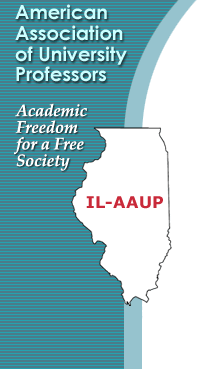Home | IL Academe | About IL AAUP | Conference Corner | Calendar | Services | Committees | Contact Us | Grants | Reports | Links
 |
 |
 |
Public Agenda for College and Career Success By Leo Welch The Illinois General Assembly by a House Joint Resolution 69 created a task force to study the issues facing Illinois higher education and to create a master plan to address these issues. The Illinois Board of Higher Education has the statutory responsibility for such master planning. The master plan produced by the IBHE task force is called the Public Agenda for College and Career Success task force chaired by IBHE chairwoman Carrie Hightman. The National Center for Higher Education Management Systems (NCHEM) of Boulder Colorado was the consulting agency. According to Chairman Hightman, over a twelve-month period the task force held six formal meetings two conference calls, and 34 regional forums at 17 community colleges and six public universities. In addition to the input received at the meetings and regional forums, I was a member of an Advisory committee invited to attend the formal Task Force meetings. I also attended the IBHE a meeting on April 26, 2008, for public university trustees at the Northern Illinois University facility in Naperville as a trustee representing Eastern Illinois University. On October 22 a regional forum was held on the campus of Eastern Illinois University which I also attended. This forum was chaired by Judy Irwin, Executive Director of the IBHE. There were three members of the Task Force also present. In addition to the input received at the meetings and regional forums, the IBHE also accepted written comments on the “Public Agenda.” On November 21, 2008, the Task Force unanimously endorsed the “Public Agenda.” The draft of the “Public Agenda” was adopted by the IBHE and was released on December 9, 2008. Significant sections of the Public Agenda include: A. A list of conditions affecting the well-being of all Illinoisans. Illinois’ population is aging and becoming rapidly and dramatically more diverse. Competition for jobs is now global with the majority of the fastest-growing and highest-paid jobs requiring at least some postsecondary education and a college credential or degree. The growth of nontraditional students and students of racial and ethnic diversity and those with disabilities is altering the face of postsecondary education. There is a convergence between the state’s economic needs and what higher education provides – knowledge, skills, training, entrepreneurialism, and the ability to work in diverse settings. There are large disparities in educational attainment by race/ethnicity, income, disability, and region. Affordability of a college education is in jeopardy. Illinois needs to increase the number of people with college degrees and other postsecondary credentials, particularly in critical needs occupations and in regions outside major metropolitan areas. The state should strengthen links between economic development needs and the research and innovation capacity of its higher education institutions. B. Five principles to guide the task force in deliberations on a master plan for higher education: Higher education is a public good and, therefore, a public responsibility. Priorities, policies, and budgets should align with state goals. Institutional and sector missions should be supported while also aligning with state goals. Adequate and equitable P-20 funding, deployed effectively and efficiently, is essential. A comprehensive P-20 student information system is vital. C. The Public Agenda for College and Career Success will create one Illinois ready to face the future. Its populace will be among the best educated in the world. It will be one of the five most affordable states in the nation in which to pursue a college education. It will have a well-educated workforce with the skills and competencies to compete in the modern economy. It will rank among the five top states in economic growth and vitality. D. To achieve this vision the Public Agenda will advance four goals: Goal 1: Increase educational attainment to match best-performing U.S. states and world countries. Recommendation 1: Increase success of students at each stage of the P-20 education pipeline to eliminate achievement gaps by race, ethnicity, socioeconomic status, gender, and disability. Recommendation 2: Increase the number of adults, including GED recipients, reentering education and completing a postsecondary credential. Recommendation 3: Reduce geographic disparities in education attainment. Goal 2: Ensure college affordability for students, families, and taxpayers. Recommendation: make Illinois one of the five most affordable states in the country measured in terms of a) the percent of family income required to pay net cost of attendance for low- and middle-income families, and b) the average amount of debt per undergraduate student. Goal 3: Increase number of quality postsecondary credentials to meet the demands of the economy. Recommendation 1: Increase the number of people with quality postsecondary credentials to ensure the state has an educated workforce and an engaged citizenry. Recommendation 2: Improve transitions all along the education pipeline, including from adult education to postsecondary education, from remedial classes to degree-bearing coursework, and from associate to baccalaureate degree levels. Recommendation 3: Increase the number of postsecondary degrees in critical skills shortages, such as, initially, Nursing, Allied Health, and Information Technology. Goal 4: Better integrate Illinois’ educational, research, and innovation assets to meet economic needs of the state and its regions. Recommendation: Boost Illinois into the ranks of the five states with the fastest growing economies through cutting-edge research, technology transfer, workforce training, innovation education, and a culture of entrepreneurship. The Public Agenda has been submitted to the Illinois General Assembly. It remains to be seen whether any or all of the goals will be met. In an era of declining support for higher education in Illinois, it would be very optimistic to expect a favorable outcome for this very ambitious master plan.
|
|